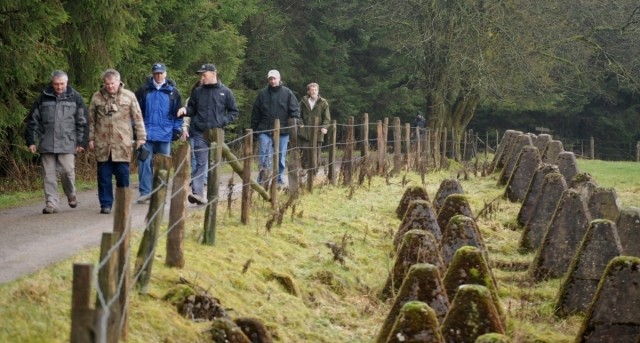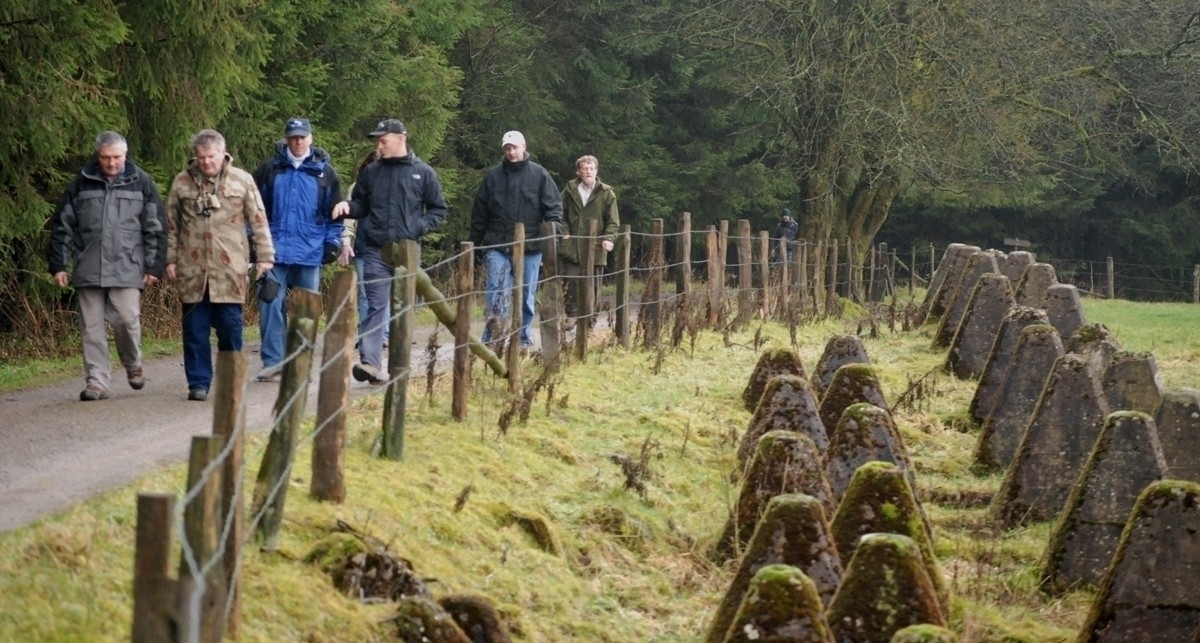BAfA"TGENBACH, Belgium (Army News Service, Dec. 14, 2007) - Mass formations of German armored vehicles and infantry quietly gathered along the Belgium and Luxembourg border, preparing for Nazi Germany's last major offensive of World War II.
The Ardennes Offensive, more popularly known as the Battle of Bulge, would begin Dec. 16, 1944. The Germans called their operation "Watch on the Rhine."
Sixty-three years later, 45 U.S. Army Garrison Heidelberg leaders and staff members retraced the route of the 6th Panzer Army's thrust into Belgium, seeing where Soldiers of the 1st U.S. Army, including those from V Corps, thwarted Hitler's plan to split the Allied advance into Germany and capture the port of Antwerp, Belgium.
Along the Bulge's North Shoulder battlefields, the staff learned about acts of great courage and heroism. They also heard of acts of great cruelty and barbarism, explained by historian Will Cavanagh, their guide for the two-day staff ride.
"Remember these people were just people. Some were good, some were better than others," said Col. Robert Ulses, USAG Heidelberg commander, during the first day's studies. "These people were running huge organizations."
Mr. Cavanagh, who has led staff rides sine 1986, recalled hearing about the battle from his mother, who lived in the area during the attack, and from personal interviews with U.S. and German veterans.
"Mr. Cavanagh made this significant event of World War II come alive with his extensive knowledge of battle details and first-hand accounts of participating Soldiers - Allied and German," said Anita Johnson, USAG Heidelberg plans, analysis and integration office. "As a result, the Battle of the Bulge became real and not just another page in the history books."
Being able to walk the battlefields, she added, "to slog through the mud, rain and cold, and to listen to the human perspective that Cavanagh added to the battle details, brought home to me that these were real people fighting under grim conditions for a cause they believed in."
The staff ride's first day concentrated on the assault route followed by Kampfgruppe (combat team) Peiper, led by Waffen-SS, Oberstleutnant (Lt. Col.) Joachim Peiper, a former adjutant to Heinrich Himmler and the youngest regimental commander in the German Army.
The German officer's column was ordered to 1st SS Panzer Division Leibstandarte Adolf Hitler, a part of the Sixth SS Panzer Army, which was assigned to capture and overrun U.S. positions with the objective of capturing the port city of Antwerp.
The Sixth SS, one of three German armies taking part in the offensive, was designated the northernmost attack force, with the primary objective of capturing Antwerp.
The center formation consisted of the Fifth Panzer Army, tasked with trying to capture Brussels via Bastogne and St. Vith, Belgium. The German Seventh Army spearheaded the attack through Luxembourg.
Kampfgruppe Peiper's column slammed into Belgium during the early morning of Dec. 16, surprising the U.S. defenders, Mr. Cavanagh said. As word of the attack spread, Peiper's tank and halftracks encountered stiff resistance from the 99th Infantry Division. Peiper was forced to change routes several times because of roadblocks and blown bridges.
Combat engineers, tank destroyer teams and the heroic actions of individual Soldiers and small units frequently thwarted Peiper's advance.
As Oberstleutnant Peiper's 15-mile long column wound its way over the narrow and twisting farm roads, several of his halftracks charged over open ground near a crossroads near the village of Baugnez Dec. 17, encountering a 13-vehicle convoy comprised of elements from the Battery B, 285th Field Artillery Observation Battalion. After a brief firefight, 84 U.S. Soldiers were rounded up and shot.
That incident became known as the "MalmAfAdy Massacre," and word of the atrocity spread through the U.S. lines and stiffened the Americans' resolve. Elements of the 82nd Infantry Division (Airborne) halted Kampfgruppe Peiper's advance at the town of Stavelot.
Running low on fuel and ammunition, Oberstleutnant Peiper pulled back to the town of La Gleize to await a resupply column. Realizing that the relief column would never arrive, he ordered his men to destroy their tanks, halftracks and other vehicles and returned to German lines Dec. 23, five days after starting his assault.
Mr. Cavanagh explained how stiff resistance by the 1st "Big Red One," 2nd "Warrior" and 99th "Battle Babies" Infantry divisions helped stem the Germans' advance and bring an end to the "Watch on the Rhine."
Entrenched U.S. formations along the "International Road" and Elsenborn Ridge, forced the Germans to commit and sacrifice many of their infantrymen and expose their armored formations to withering artillery fire, Mr. Cavanagh said.
Soldiers of the 2nd Infantry Division would earn more Medals of Honor than any other U.S. unit during the fight, and the "Manchus" of the 1st Battalion, 9th Infantry Regiment fighting at the Rocherather Baracken crossroads saved the entire 1st Army from being overrun, Mr. Cavanagh said.
"I hope this ride gives (the garrison staff) great pride in their country - in the past and today," Mr. Cavanagh said at the ride's final stop in a memorial park, dedicated to the 2nd and 99th Infantry Division, in the village of Krinkelt. "What the Soldiers did was give a lot of freedom to a lot of people."
Capt. Katherine Baker, USAG Kaiserslautern logistics directorate, said she learned several tactical, logistical lessons and to never make assumptions about an enemy.
"Complacency on the side of the Allies almost made Hitler's final offensive a success," she said. "Allied soldiers had a false sense of security that was exploited. There were simple things that could have been done to quickly slow the German advance, but no one had a contingency plan because everyone assumed the Germans could not mount such an attack."
(Dave Melancon serves with Army Garrison Heidelberg Public Affairs.)


Social Sharing